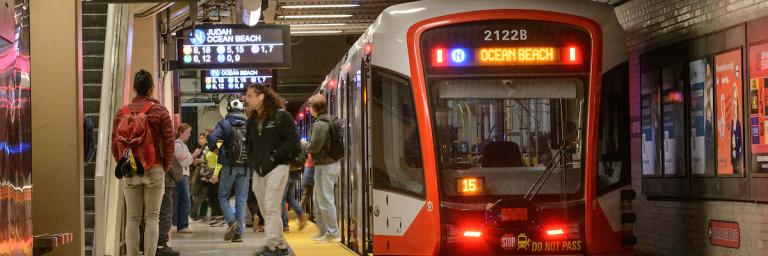On December 2, the SFMTA Board of Directors unanimously approved the Muni Metro Capacity Study final report.
Muni Metro is one of only a handful of “legacy” systems in the country. Much of the system’s origins date back over a hundred years to the first era of urban streetcar systems. In the 1970s, when BART was constructed, Muni’s streetcar lines began running in the Market Street subway. Muni Metro was born. San Francisco has changed dramatically since then and will certainly continue to change over future decades.
The Muni Metro Capacity Study looks ahead to plan for more people using Muni Metro in the future. It explores changes we could make, if necessary, to improve Muni Metro service. The changes could make service more reliable, prevent crowding, delays and pass-ups.
This is part of the Muni Metro Modernization Program – a larger, coordinated effort to address multiple Muni Metro improvements.
The ConnectSF Transit Strategy is San Francisco’s long-range transit vision. The strategy recommends a federal Core Capacity grant program to modernize Muni Metro.
What is the purpose of the Muni Metro Capacity Study?
Muni Metro is experiencing both aging pains and growing pains. Much of the Muni Metro system’s infrastructure is old and in need of replacement. At the same time, we are experiencing crowding in some portions of the system today. And we want to be prepared to handle higher ridership in the future, if needed.
The Study’s goal is to develop a program of capital projects for the next 10-15 years. These projects would allow us to expand our system capacity. They would be combined with maintenance work to replace old Muni infrastructure.
Why now?
The SFMTA is working to address our financial crisis so we can keep day to day Muni serve running. At the same time, we need to continue to plan for the future.
Parts of our Muni Metro system are long-overdue for major renewal that is currently unfunded. Packaging new infrastructure and capacity upgrades may allow us to access substantial funding to cover critical needs.
This Study will help us get into the pipeline for a Federal Transit Administration (FTA) Core Capacity grant. This grant is perfect for systems like Muni Metro that have both aging infrastructure overdue for replacement and need to expand capacity for growing ridership.
While the federal environment is uncertain, we must do all we can to be competitive. It can take four to six years between entering the grant pipeline and receiving an award.
What we’ve been studying
We are just starting to define potential future projects. First, we will complete this Muni Metro Capacity Study. Then, specific projects will have to be developed further in partnership with the affected communities. Here are some of the capital strategies we’ve explored:
- Upgrade old infrastructure to add capacity. This may include new light rail track, overhead wires and traction power.
- Expand infrastructure that prioritizes transit. This includes transit lanes, expanded signal priority, and signal pre-emption. It also could include crossing gates at select locations.
- Upgrade infrastructure to accommodate three-car trains on the N Judah and between SF State and downtown.
- Boarding infrastructure for three-car trains, including upgrades to station accessibility.
- Infrastructure to provide flexibility for different service patterns in the future.
We also explored restructuring service to remove one or more lines from the Market Street subway. This strategy could improve Muni Metro capacity by allowing more space in the subway for longer, three-car trains. Some riders would need to transfer. But we found that even in our highest future ridership forecast, we do not need to use this strategy in the 10–15-year timeframe of our capital program.
We also considered whether we may need to remove a line from the subway beyond the 10–15-year timeframe. We found that it would depend on the amount of future ridership growth. And there are other options that we could consider instead.
We would only explore removing a line from the subway in the future if ridership increases significantly or subway performance declines. And any changes would include extensive community outreach.
Study Timeline
Late 2023 – early 2025: Study capacity options in consultation with technical experts and public representatives.
Early 2025 – Fall 2025: Draft Study recommendations, conduct outreach to share findings with the broader public, and gather feedback to refine the recommendations.
Late 2025: Finalize the Study recommendations, document in a final report, and present to the SFMTA Board of Directors.
Public Outreach and Engagement in the Study
Public input is an important aspect of the Muni Metro Capacity Study.
There are several ways the public can provide feedback on the Study.
- Any member of the public can email us with questions, comments, ideas and concerns.
- 2023-2025: An informal Community Working Group representing a broad cross-section of Muni Metro stakeholders meets every few months. They discuss and consider the strategies and tradeoffs we are exploring in the Study and how best to balance these to develop a future vision for Muni Metro. Read more about the Community Working Group.
- 2024: Multilingual focus groups representing a wide range of Muni Metro rider demographics were convened to solicit feedback on strategies. All focus groups included people who ride each Muni Metro line. They also included people of different ages, abilities, income and education levels.
- Fall 2025: At-large public outreach to share and seek feedback on our draft recommendations.
